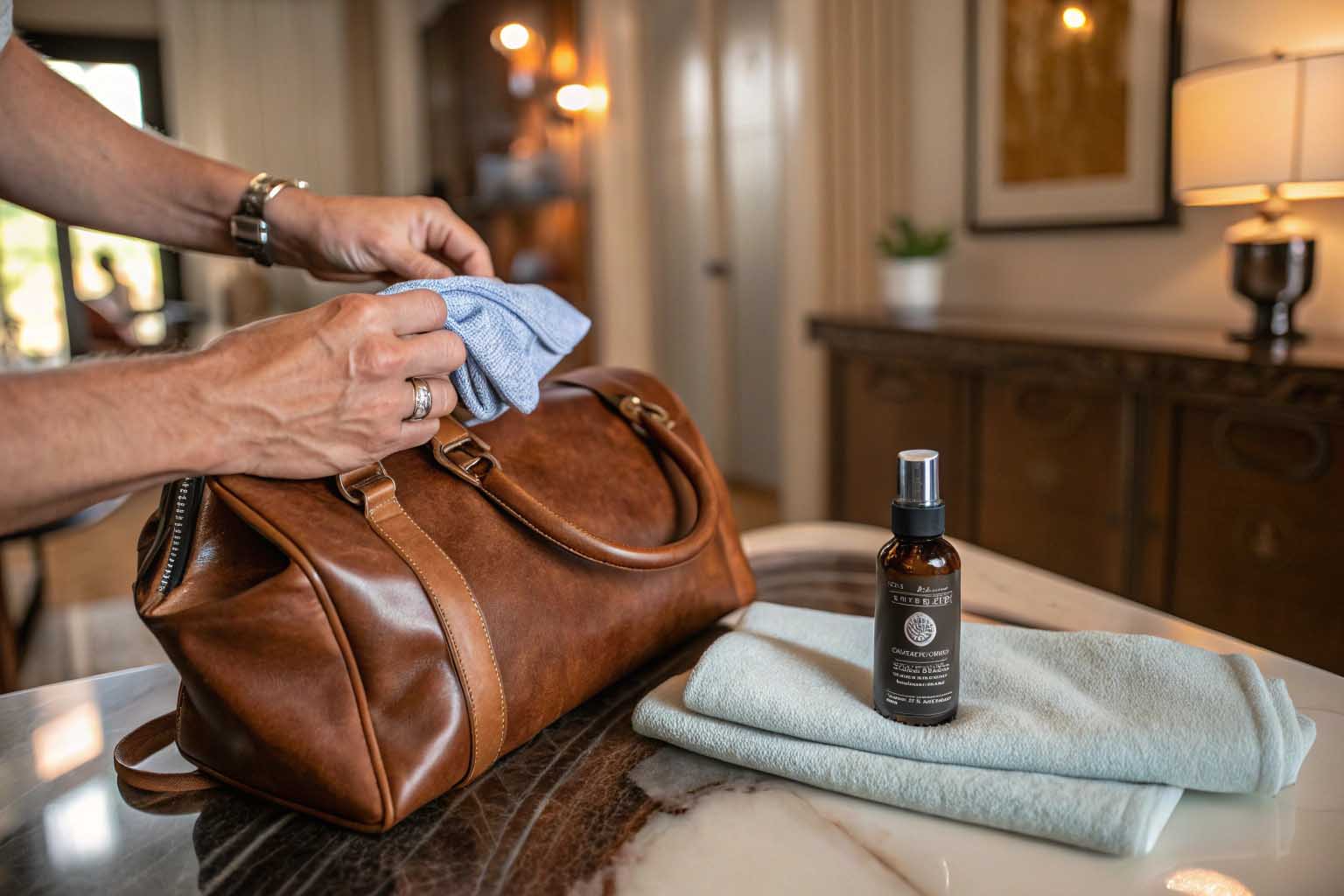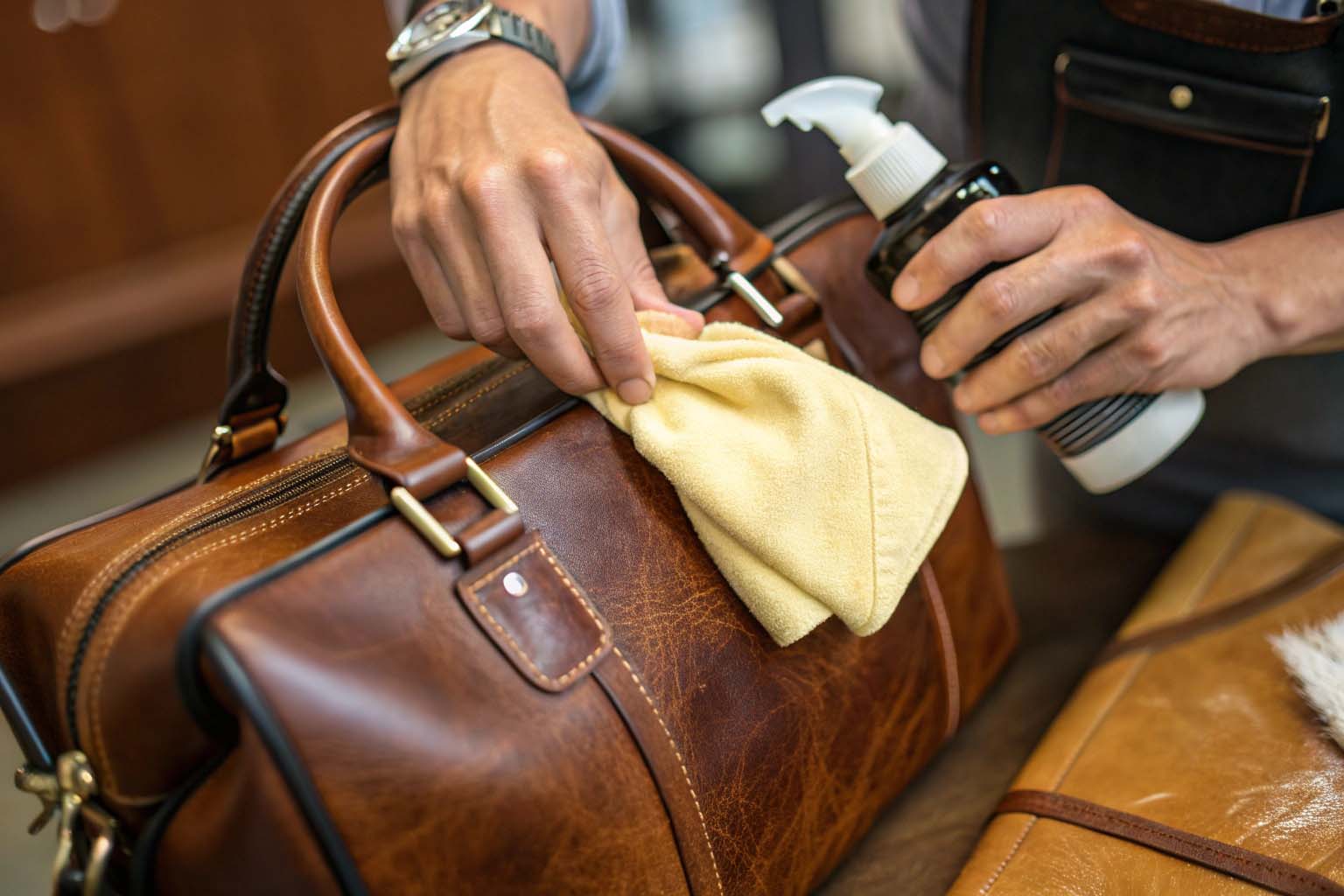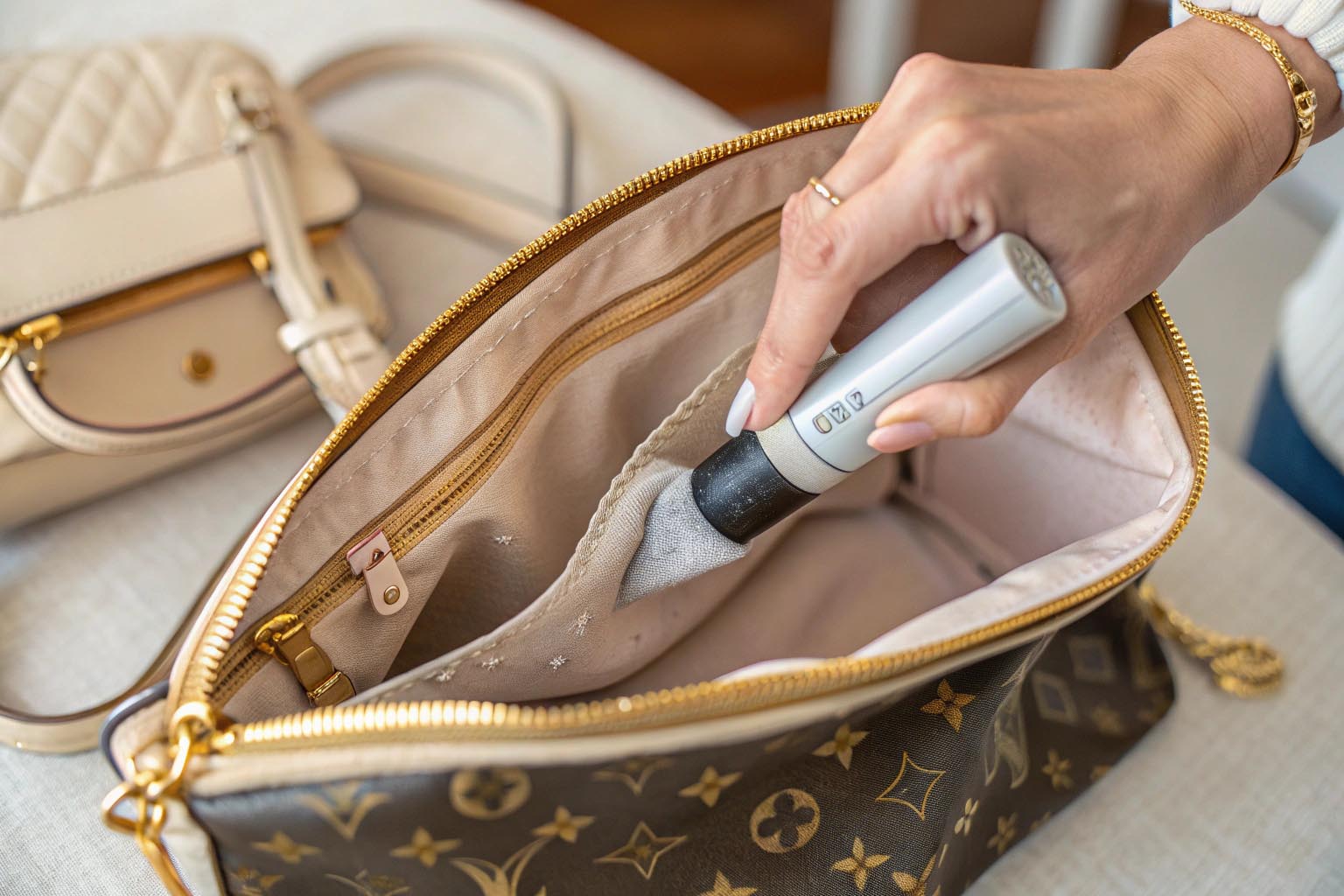Haben Sie Angst, Ihre teure Tasche mit dem falschen Reinigungsmittel zu ruinieren? Schmutz, verschüttete Flüssigkeiten und die Zeit können ihre Schönheit und ihren Wert beeinträchtigen. Entdecken Sie hier sichere und effektive Pflegemethoden.
Zur richtigen Pflege gehören die Kenntnis des Materials (Leder, Segeltuch usw.), die Verwendung spezieller Reinigungsmittel, schonende Techniken und eine konsequente Pflege. Informieren Sie sich in den Anleitungen der Hersteller, nehmen Sie gelegentlich professionelle Dienste in Anspruch, und üben Sie täglich gute Gewohnheiten, damit Ihre Luxustasche immer gut aussieht.

![]()
Es ist keine Zauberei, die schöne Tasche wie neu aussehen zu lassen, aber es erfordert das richtige Wissen. Genau zu wissen wie Die Behandlung der verschiedenen Materialien ist entscheidend. Beginnen wir mit klassischem Leder und gehen wir auf die Besonderheiten einiger gängiger Materialien ein. Lesen Sie weiter, um die besten Praktiken zu erfahren.
Wie lassen sich Ledertaschen am effektivsten reinigen, ohne sie zu beschädigen?
Haben Sie Angst, Ihre wertvolle Ledertasche abzuwischen? Die Verwendung von scharfen Chemikalien oder zu viel Wasser kann zu irreversiblem Austrocknen, Rissen oder Flecken führen. Lernen Sie sanfte, effektive Lederreinigungstechniken.
Verwenden Sie einen speziellen Lederreiniger oder eine in destilliertem Wasser verdünnte milde Seife. Tragen Sie es mit einem weichen, feuchten Tuch auf und wischen Sie es vorsichtig ab. Testen Sie immer zuerst an einer unauffälligen Stelle. Konditionieren Sie das Leder anschließend, um die Feuchtigkeit wiederherzustellen und die Lederoberfläche zu schützen. Weichen Sie die Tasche niemals ein.

Die Pflege von Leder erfordert einen sanften Umgang und die richtigen Produkte. Aus meiner Erfahrung bei der Beschaffung von Materialien für Marken weiß ich, dass Qualitätsleder die richtige Pflege verdient.
Identifizierung Ihres Ledertyps
Identifizierung Ihres Ledertyps
Zunächst ist es hilfreich zu wissen, mit welcher Art von Leder man es zu tun hat. Ist es glattes Kalbsleder1Kieselstruktur, zartes Wildleder oder vielleicht Lackleder? Manchmal liefert die Marke diese Informationen. Wenn nicht, hilft vielleicht eine kurze Suche nach Ihrem Taschenmodell. Wildleder und Nubuk2 benötigen eine ganz andere Pflege (meist trockene Methoden wie Bürsten) als Glattleder.
Schritt-für-Schritt-Reinigungsverfahren
Bei den meisten gängigen Glattledern leeren Sie zunächst den Beutel vollständig aus. Verwenden Sie ein trockenes, weiches Mikrofasertuch, um jeglichen Oberflächenschmutz abzustauben. Nehmen Sie dann ein anderes sauberes Tuch und befeuchten Sie es ganz leicht mit destilliertem Wasser. Sie können einen kleinen Tropfen pH-neutrale Seife oder einen speziellen Lederreiniger hinzufügen. Testen Sie dies immer zuerst an einer versteckten Stelle, z. B. an der Unterseite eines Riemens oder einer Innenklappe. Wischen Sie die Lederoberfläche sanft ab, und zwar in Richtung der Maserung, falls diese sichtbar ist. Vermeiden Sie starkes Reiben oder Durchnässen des Leders.
Konditionierung ist ausschlaggebend
Nachdem Sie die Tasche gereinigt und vollständig an der Luft getrocknet haben (nicht in der Hitze!), ist die Pflege der nächste wichtige Schritt. Leder ist eine Haut, die Feuchtigkeit braucht, um flexibel zu bleiben und Risse zu vermeiden. Geben Sie eine kleine Menge eines hochwertigen Lederpflegemittels auf ein sauberes, weiches Tuch und reiben Sie es mit kreisenden Bewegungen sanft in das Leder ein. Lassen Sie es eine Weile einziehen (beachten Sie die Anweisungen für den Conditioner), und polieren Sie es dann vorsichtig mit einem anderen sauberen Tuch ab. Auf diese Weise werden die ätherischen Öle wiederhergestellt und eine Schutzschicht hinzugefügt.
| Leder Typ | Reinigungsmethode | Konditionierung |
|---|---|---|
| Glatt (z. B. Kalb) | Feuchtes Tuch, milder Reiniger, sanfte Tücher | Ja, regelmäßig |
| Wildleder/Nubuk | Wildlederbürste, spezieller Radiergummi/Reiniger | Schutzspray für Wildleder |
| Patent | Feuchtes Tuch, spezieller Lackreiniger/Politur | Nein (normalerweise) |
| Exotisch (z. B. Krokodil) | Feuchtes Tuch, der Maserung folgen, fachkundige Beratung | Spezialisiertes Produkt |
Wie sollte man Segeltuchtaschen mit Lederbesatz pflegen?
Die Reinigung von Segeltuch scheint einfach, aber was ist mit den Lederteilen? Wasser oder scharfe Reinigungsmittel auf dem Segeltuch können auf die Lederverkleidung übergehen oder diese beschädigen. Erfahren Sie, wie Sie beides sicher reinigen können.
Reinigen Sie das Segeltuch und das Leder getrennt. Verwenden Sie einen Textilreiniger oder eine milde Seife für das Segeltuch, ohne das Leder zu berühren. Schützen Sie die Lederverkleidung während der Reinigung des Segeltuchs. Reinigen Sie die Lederteile mit geeigneten Lederpflegemitteln und achten Sie darauf, dass das Segeltuch nicht verschmutzt wird.

![]()
Taschen aus einer Kombination von Segeltuch und Leder sind sehr beliebt, müssen aber bei der Reinigung sorgfältig behandelt werden. Man muss jedes Material richtig behandeln, ohne das andere zu beschädigen.
Schutz der Verkleidung
Die größte Herausforderung besteht darin, Schäden oder Farbübertragungen zwischen Leinwand und Leder zu vermeiden. Bevor Sie überhaupt mit der Reinigung der Leinwand beginnen, schlage ich oft vor, die Lederteile zu schützen. Sie können die Ledergriffe, Ecken oder Zierleisten vorsichtig mit Malerband abkleben. Dadurch entsteht eine Barriere, die besonders hilfreich ist, wenn Sie mehr als nur eine kurze Reinigung vornehmen.
Reinigung der Segeltuchsektion
Sobald das Leder geschützt ist, widmen Sie sich der Leinwand. Beginnen Sie mit einer weichen Bürste oder einem trockenen Tuch, um losen Schmutz und Staub zu entfernen. Zur Reinigung von Flecken oder allgemeinem Schmutz mischen Sie einen sanften Textilreiniger oder eine kleine Menge eines milden Waschmittels (wie Woolite) mit kaltem Wasser. Befeuchten Sie ein sauberes Tuch oder einen Schwamm mit der Lösung - achten Sie darauf, dass es feucht, aber nicht klatschnass ist. Reiben Sie die Leinwand sanft ab und bearbeiten Sie dabei die fleckigen Stellen. Vermeiden Sie zu starkes Schrubben. Wischen Sie mit einem sauberen, nur mit Wasser angefeuchteten Tuch nach.
Ansprache der Lederdetails
Nachdem das Segeltuch sauber und idealerweise trocken ist (oder während es trocknet, wenn Sie es gut abgeklebt haben), können Sie sich an die Lederbesätze machen. Entfernen Sie vorsichtig alle Schutzbänder. Wenden Sie die bereits erwähnten Methoden zur Lederreinigung an: ein weiches Tuch, das leicht mit einem speziellen Lederreiniger angefeuchtet ist. Wischen Sie es vorsichtig ab und lassen Sie es dann trocknen. Tragen Sie anschließend einen Lederconditioner auf die Verkleidung auf, um sie mit Feuchtigkeit zu versorgen und zu schützen. Lassen Sie die gesamte Tasche an einem gut belüfteten Ort ohne direkte Sonneneinstrahlung oder Hitze vollständig an der Luft trocknen, bevor Sie sie wieder benutzen.
| Komponente | Reinigungswerkzeug | Reinigungsmittel | Schlüssel Vorsichtsmaßnahme |
|---|---|---|---|
| Segeltuch | Weiche Bürste, Lappen | Textilreiniger/Milde Seife | Durchnässen vermeiden |
| Leder | Weicher Stoff | Leder-Reiniger | Segeltuch schützen |
| Beide | Lufttrocknung (keine Hitze) | Getrennte Reinigung | Abdeckklebeband (optional) |
Welche Methoden eignen sich am besten, um Schimmel von Designer-Handtaschen zu entfernen?
Haben Sie die gefürchteten Schimmelflecken auf Ihrer Luxustasche entdeckt? Schimmel kann dauerhaft Flecken hinterlassen, Materialien schwächen und unangenehme Gerüche verursachen, wenn er nicht richtig behandelt wird. Entdecken Sie sichere Methoden zur Bekämpfung von Schimmelpilzbefall.
Bürsten Sie zunächst den losen Schimmel im Freien vorsichtig ab. Leder mit einer Mischung aus gleichen Teilen weißem Essig und Wasser abwischen, dann reinigen und pflegen. Für Textilien verwenden Sie einen Textilreiniger oder verdünnten Essig, den Sie vorher testen. Sorgen Sie für eine gründliche Trocknung im Sonnenlicht, wenn möglich.

Die Entdeckung von Schimmel auf einer geliebten Tasche ist enttäuschend, kann aber oft behandelt werden, wenn man vorsichtig vorgeht. Es ist wichtig, richtig damit umzugehen, um zu vermeiden, dass sich Sporen ausbreiten oder die Tasche weiter beschädigt wird.
Sicherheit geht vor: Arbeiten mit Schimmel
Schimmel ist nicht nur hässlich, er kann auch gesundheitsschädlich sein. Ich empfehle immer, schimmelige Gegenstände möglichst im Freien oder in einem sehr gut belüfteten Bereich zu behandeln. Tragen Sie Einweghandschuhe und ziehen Sie eine Staubmaske in Betracht, um das Einatmen von Schimmelsporen zu vermeiden. Ihre Sicherheit steht an erster Stelle.
Behandlung von Schimmel auf Leder
Nehmen Sie zunächst eine weiche Bürste (z. B. eine alte Zahnbürste) und bürsten Sie den sichtbaren, losen Schimmel vorsichtig von der Lederoberfläche ab. Tun Sie dies im Freien, um zu verhindern, dass sich die Sporen im Inneren ausbreiten. Bereiten Sie dann eine Lösung aus gleichen Teilen weißer Essig3 und destilliertem Wasser. Essig ist eine milde Säure, die hilft, die Schimmelpilzsporen4. Befeuchten Sie ein sauberes Tuch mit dieser Lösung - auch hier gilt: feucht, nicht nass. Wischen Sie die schimmeligen Stellen vorsichtig ab. Wischen Sie anschließend mit einem Tuch nach, das nur mit klarem Wasser angefeuchtet wurde. Lassen Sie den Beutel vollständig an der Luft trocknen. Kurzes, indirektes Sonnenlicht kann helfen, verbliebene Sporen abzutöten, aber lassen Sie die Tasche nicht stundenlang in der Sonne liegen, da dies das Leder beschädigen kann. Führen Sie nach dem Trocknen eine normale Lederreinigung durch und tragen Sie einen guten Conditioner auf, um die Feuchtigkeit wiederherzustellen.
Behandlung von Schimmel auf Gewebe/Leinwand
Bei Innen- oder Außenverkleidungen aus Stoff oder Segeltuch ist das Verfahren ähnlich. Bürsten Sie zuerst den losen Schimmel im Freien ab. Sie können die gleiche verdünnte Essiglösung verwenden, wobei Sie immer zuerst an einer unauffälligen Stelle testen sollten, um sicherzustellen, dass sie keine Verfärbungen verursacht. Alternativ können Sie auch einen Textilreiniger verwenden, der speziell für die Behandlung von Schimmelpilzen entwickelt wurde. Wenden Sie den Reiniger gemäß den Anweisungen des Produkts an, in der Regel durch leichtes Reiben mit einem Tuch. Wischen Sie anschließend mit einem sauberen, feuchten Tuch nach.
Prävention ist der Schlüssel
Nach einer erfolgreichen Behandlung ist es wichtig, einen Rückfall zu verhindern. Stellen Sie sicher, dass die Tasche 100% trocken ist, bevor Sie sie aufbewahren. Lagern Sie Ihre Luxustaschen an einem kühlen, trockenen Ort mit guter Luftzirkulation. Vermeiden Sie feuchte Kellerräume oder feuchte Schränke. Die Verwendung von Silikagel-Paketen im Inneren der Tasche und des Staubbeutels kann ebenfalls dazu beitragen, überschüssige Feuchtigkeit zu absorbieren. Richtige Lagerung ist der beste Schutz gegen Schimmel.
Wie oft sollte man eine Luxustasche aus Leder reinigen und pflegen?
Sind Sie unsicher, wie oft Ihre Ledertasche gepflegt werden muss? Zu häufiges Reinigen kann Öle entfernen, während zu seltenes Reinigen zu Schmutzablagerungen und Austrocknung führt. Finden Sie den richtigen Reinigungsplan.
Eine leichte Reinigung (Abwischen von Staub) kann nach jedem Gebrauch oder wöchentlich erfolgen. Eine gründlichere Reinigung und Pflege hängt von der Nutzung ab, in der Regel alle 2-6 Monate. In trockenen Klimazonen oder wenn sich die Tasche steif anfühlt, sollten Sie sie häufiger pflegen. Beobachten Sie den Zustand Ihrer Tasche.

Den perfekten Rhythmus für die Reinigung und Pflege Ihrer Ledertasche zu finden, ist keine exakte Wissenschaft, sondern eher eine Frage der Beobachtung und des Verständnisses der Nutzungsmuster. Das ist eine Frage, die ich oft mit Kunden bespreche, die auf der Suche nach langlebigen Taschen sind.
Faktoren, die die Häufigkeit beeinflussen
Es gibt mehrere Faktoren, die bestimmen, wie oft Ihre Tasche gewartet werden muss. Wie häufig tragen Sie sie? Eine Tasche, die Sie täglich tragen, braucht häufiger Pflege als eine, die Sie für besondere Anlässe aufheben. In welchem Klima leben Sie? Trockene Luft entzieht dem Leder schneller Feuchtigkeit, so dass es häufiger gepflegt werden muss. Bei feuchter Luft muss das Leder vielleicht häufiger auf Schimmelbefall überprüft werden, aber vielleicht weniger gepflegt werden. Auch die Art und Farbe des Leders spielt eine Rolle - helle Farben lassen Schmutz schnell erkennen, während einige robuste Lederarten eher nachsichtig sind.
Routinemäßiges Abwischen vs. Tiefenreinigung
Ich bin ein großer Verfechter der vorbeugenden Pflege. Ein kurzes Abwischen mit einem trockenen, weichen Mikrofasertuch nach jedem Gebrauch oder zumindest wöchentlich wirkt Wunder. Dadurch werden Oberflächenstaub und Öle entfernt, bevor sie sich festsetzen können. Stellen Sie sich das wie das tägliche Abstauben Ihrer Möbel vor. Eine gründlichere Reinigung mit einem speziellen Lederreiniger ist seltener erforderlich. Bei einer regelmäßig verwendeten Tasche sollten Sie eine Reinigung alle 2 bis 6 Monate anstreben. Wenn Sie die Tasche nur gelegentlich benutzen, reicht es vielleicht, sie alle 6 bis 12 Monate zu reinigen.
Konditionierung Kadenz
Die Konditionierung sollte in der Regel auf eine Tiefenreinigung folgen. Daher gilt auch hier der Zeitrahmen von 2-6 Monaten (regelmäßiger Gebrauch) oder 6-12 Monaten (gelegentlicher Gebrauch). Hören Sie jedoch auf Ihre Tasche! Wenn sich das Leder merklich trocken, steif oder weniger geschmeidig anfühlt, ist das ein Zeichen dafür, dass es gepflegt werden muss, auch wenn es noch nicht so lange her ist. In sehr trockenen Klimazonen müssen Sie das Leder möglicherweise alle 1-3 Monate pflegen. Eine Überkonditionierung kann ebenfalls ein Problem darstellen (das Leder fühlt sich dann klebrig an), also übertreiben Sie es nicht - tragen Sie nur dünne Schichten auf.
| Pflegeart | Häufigkeit (regelmäßige Nutzung) | Häufigkeit (gelegentlicher Gebrauch) | Schlüsselindikator |
|---|---|---|---|
| Abstauben | Nach Gebrauch / Wöchentlich | Vor/Nach der Lagerung | Sichtbarer Staub |
| Tiefenreinigung | 2-6 Monate | 6-12 Monate | Verschmutzung / Trübheit |
| Konditionierung | 2-6 Monate | 6-12 Monate | Trockenheit/Steifheit |
Wie lässt sich das Innenfutter von Designer-Handtaschen am sichersten reinigen?
Sie haben Make-up oder Tinte in Ihrer schönen Tasche verschüttet? Es kann schwierig sein, das Innenfutter zu reinigen, ohne es oder das Äußere zu beschädigen. Lernen Sie sichere Methoden für die Innenreinigung.
Leeren Sie den Beutel vollständig aus. Ziehen Sie das Futter heraus, wenn möglich. Verwenden Sie eine Fusselrolle oder eine Staubsaugerdüse für Verschmutzungen. Reinigen Sie Flecken mit einem Textilreiniger oder verdünnter milder Seife auf einem feuchten Tuch. Erst testen. Nicht durchnässen. Gründlich an der Luft trocknen.

Seien wir ehrlich: Im Inneren einer Tasche passiert oft mehr - und mehr Unfälle - als auf der Außenseite. Krümel, Stiftspuren, verschüttetes Make-up... das kommt vor! Bei der Reinigung des Innenfutters ist Vorsicht geboten, damit das Gewebe nicht beschädigt wird oder Feuchtigkeit auf das Äußere der Tasche gelangt.
Vorbereitung ist der Schlüssel
Das Wichtigste zuerst: Leeren Sie die Tasche vollständig aus. Überprüfen Sie jede einzelne Tasche und jedes Fach. Drehen Sie die Tasche über einem Mülleimer um und schütteln Sie sie leicht, um lose Verunreinigungen zu entfernen. Wenn das Innenfutter so konzipiert ist, dass es ganz oder teilweise aus der Tasche herausgezogen werden kann, tun Sie das vorsichtig. Das macht die Reinigung viel einfacher und schont das Außenmaterial.
Allgemeine Reinigungsschritte
Sobald die Verkleidung zugänglich ist, nehmen Sie eine Fusselrolle und gehen damit über die gesamte Oberfläche, um Staub, Haare und kleine Partikel aufzusaugen. Ein Staubsauger mit einem weichen Bürstenaufsatz auf niedriger Stufe funktioniert ebenfalls gut. Bei allgemeinen Verschmutzungen oder schwachen Flecken feuchten Sie ein sauberes Mikrofasertuch ganz leicht mit Wasser an. Sie können einen winzigen Tropfen milder Seife (wie Castile-Seife oder Baby-Shampoo) oder einen sanften Textilreiniger hinzufügen. Testen Sie diese Lösung immer zuerst an einer verdeckten Innennaht, um die Farbechtheit oder Wasserflecken zu prüfen. Wischen Sie das Futter sanft ab. Vermeiden Sie es, es zu nass zu machen.
Bekämpfung bestimmter Flecken (Tinte, Make-up)
Bei bestimmten, hartnäckigeren Flecken ist schnelles Handeln angesagt. Tupfen Sie frische Flecken sofort mit einem sauberen, trockenen Tuch ab - nicht reiben, da sich der Fleck sonst ausbreiten kann.
- Tinte: Das ist bekanntermaßen schwierig. Manchmal lässt sich Kugelschreibertinte durch vorsichtiges Betupfen (nicht Reiben) mit einem in Isopropylalkohol getauchten Wattestäbchen entfernen, aber Testen Sie es zuerst an einer versteckten Stelle da es Farbe entfernen oder bestimmte Stoffe beschädigen kann. Früher war Haarspray ein guter Trick, aber die Formeln variieren jetzt stark. Bei schweren Tintenflecken ist möglicherweise professionelle Hilfe erforderlich.
- Make-up: Bei verschüttetem Puder versuchen Sie, so viel wie möglich mit Klebeband oder einer Fusselrolle aufzunehmen, bevor Sie ihn abwischen. Bei flüssiger Grundierung oder Lippenstift kann manchmal ein ölfreier Make-up-Entferner oder ein mit Mizellenwasser befeuchtetes Tuch helfen. Auch hier gilt: erst testen und dann vorsichtig abtupfen.
Lassen Sie das Futter nach einer Fleckenbehandlung oder allgemeinen Reinigung vollständig an der Luft trocknen, wenn möglich ausgezogen, bevor Sie etwas in die Tasche zurücklegen. Verwenden Sie niemals einen Haartrockner, da Hitze das Gewebe beschädigen oder die Struktur der Tasche beeinträchtigen kann.
Schlussfolgerung
Wenn Sie die Ratschläge des Herstellers befolgen, gelegentlich professionelle Hilfe in Anspruch nehmen und eine konsequente tägliche Pflege praktizieren, bleiben Ihre Luxustaschen schön und halten länger.
-
Die Kenntnis von glattem Kalbsleder wird Ihnen helfen, seine Qualität und sein Aussehen effektiv zu erhalten. ↩
-
Entdecken Sie die einzigartigen Eigenschaften von Nubukleder und erfahren Sie, wie man es richtig pflegt, um seine Langlebigkeit zu gewährleisten. ↩
-
Wenn Sie die Vorteile von weißem Essig bei der Reinigung erforschen, können Sie natürliche und wirksame Lösungen für die Lederpflege finden. ↩
-
Wenn Sie wissen, wie Sie Schimmelsporen auf Leder wirksam abtöten können, können Sie die Qualität und Langlebigkeit Ihrer Lederartikel erhalten. ↩


